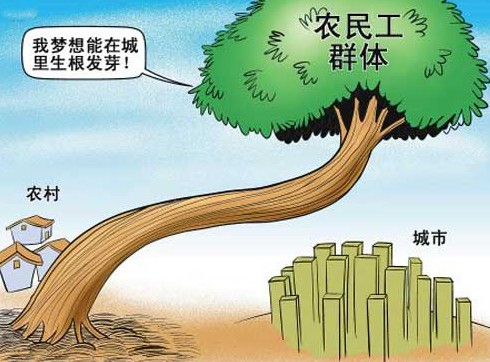Achieving coordinated rural and urban modernization
- By Li Changping
 0 Comment(s)
0 Comment(s) Print
Print E-mail China.org.cn, October 29, 2012
E-mail China.org.cn, October 29, 2012
High industrialization, low urbanization
Since 1978, China’s industrialization and urbanization have been developing rapidly for more than 30 years. But during the same period, China’s farmer population has also increased from 700 million to 900 million. Following the 2008 global financial crisis, over 20 million Chinese peasant workers returned to the countryside.
In the developed world, 70 percent of GDP from the manufacturing industry converts to national revenue, while the conversion rate in developing countries is only 35 to 40 percent. Wages for laborers in developing countries are so low that urbanization of rural areas has been difficult to push forward.
Export model a ‘turning point’ for China
Prior to the rise of China’s current export-driven economic model, the normal pattern was that the minority produced for the majority. Following this turning point, the majority now produces for the minority.
Before this turning point, 70 percent of GDP from the manufacturing industry converted to national revenue and urbanization could be completed at the middle and late period of industrialization. But following the turning point, the conversion rate is only 35 to 40 percent. Because wages have fallen behind other countries during this process, urbanization in China has fallen greatly behind industrialization.
China must avoid repeat of 1997 measures
Many policymakers believe China should address the current situation like the country did during the 1997 Asian financial crisis – by substantially increasing fiscal investment to maintain rapid economic growth and social stability. At the same time, the country attempts to use export tax rebates and increase liquidity to help bolster exporters on China’s southeast coast.
However, the global financial crisis today is not the same as the Asian financial crisis in 1997. 1997 was just the beginning of a boom period for export-driven industrialization in China, which is now nearing its final stage. If China adopts measures similar to what it did in 1997, it could intensify overproduction and cause an even larger financial crisis.
Even though most developed countries have bottomed out after the 2008 crisis, China is unlikely to regain its 2007 growth rate. For one, developed countries, with nearly unlimited consumer options, may not continue to prefer Chinese-made products. Secondly, Chinese manufacturers in the country’s coastal areas have already lost their low-cost advantage.
Preventing the “Haikou Model”
A low growth rate is not entirely a bad thing. Japan has been developing at low growth rate for nearly 30 years. The experience and lessons of Japan are very valuable for Chinese coastal areas to deal with the current crisis. For the last 30 years, Japan has consistently exported industrial products, capital, technology, and management overseas. Although the Japanese economic growth rate has been stagnant or even negative at times, Japan faces no serious social problems and people’s living standards have increased steadily.
How can exporting industries and capital help the mainland get through this crisis? The reason is that the export-driven model becomes obsolete once urbanization and modernization are realized. A modernized country should actively export excess industries, capital, brands, technology, management and talents to undeveloped areas and make use of the land, labor, resources and environment in other countries to create wealth. Although this will slow down GDP growth, people’s wealth accumulation will speed up.
The problems that Chinese southeast coastal areas face today fall into the same category with Japan and other “Asian tigers”. Limited financial power should be used for societal upgrades, including the development of an environment protection industry.
Around 1990, Haikou in Hainan and Beihai in Guangxi were fast-growing areas in China. But after the “Asian Financial Storm” in 1997, they fell into decline and were forgotten over the ensuing ten-year period. In a larger sense, if the sudden slowdown of a rapidly growing economy is not dealt with properly, it may lead to wider economic problems, even causing entire local economies to fail.
|
|
The future of China’s migrants
At present, the governments of many coastal cities have abundant financial resources, which with proper use can help them weather the current crisis. Otherwise, these regions could suffer the same fate as Haikou. Now these local governments consider rural migrants as a burden and shout out with one voice – “rural migrants go home to seek employment”. This tone, however, just accelerates the “Haikou model”.
How can absorbing the migrant population and upgrading social welfare conditions prevent “Haikou model”? After much of the manufacturing sector moves offshore, the economy will start to move towards the service industry. The higher the standard of a city’s social security, the faster the service industry can develop. Once this occurs, fiscal revenue can increase at a steady pace. The governments should change migrants into urban residents instead of turning them away.
In the coming 30 years, China’s total population will not be less than 1.5 billion. Even if 15 million migrants can become urban residents each year, the number of Chinese peasants will not be less than 500 million 30 years later.
A key to achieving coordinated rural and urban development will be to set the conditions for 500 million peasants to enjoy the same basic living standards that their urban compatriots enjoy. In this sense, steps must be taken to ensure stability of rural economic systems. .
The author now works with the Research Center for Rural Construction, Hebei University.
This post was published in Chinese and translated by An Wei.
Opinion articles reflect the views of their authors, not necessarily those of China.org.cn.







